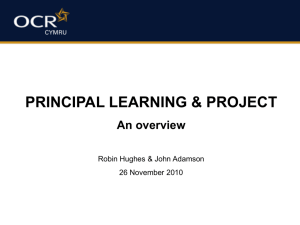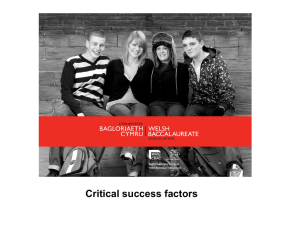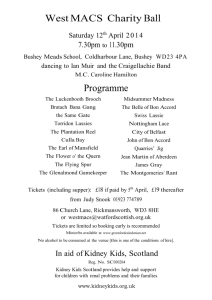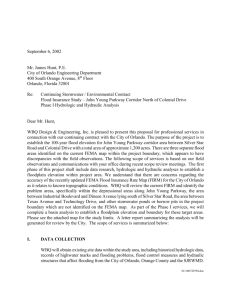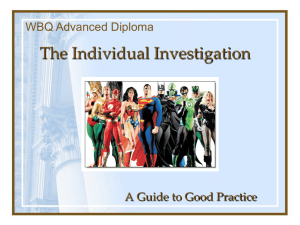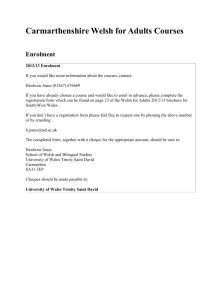Robin Clutterbuck
advertisement
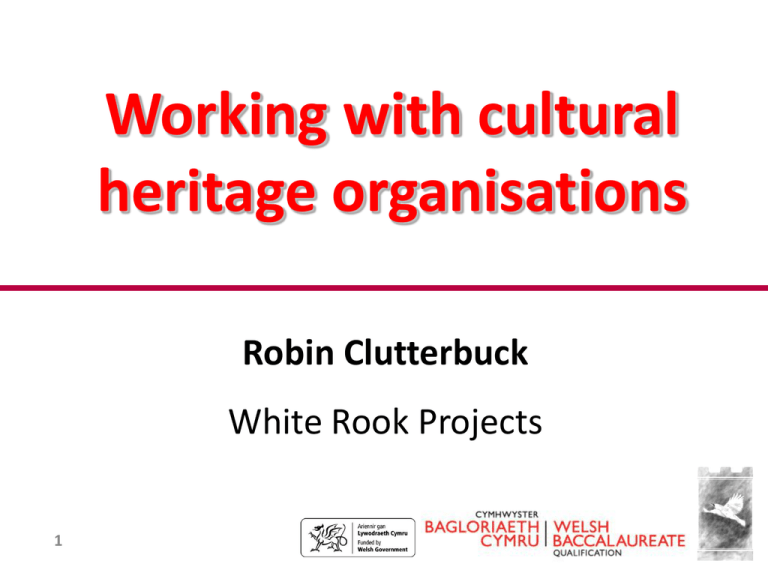
Working with cultural heritage organisations Robin Clutterbuck White Rook Projects 1 Research project 2007-8 Managed by Caerphilly County Borough Council Funded by CyMAL Partners – – – – – 2 Coleg Gwent (FE) National Museum Wales Glamorgan Archives Welsh Federation of Museums WJEC / WBQ Research project The brief Research and develop the means by which Museums, Libraries and Archive services can support the Welsh Baccalaureate: - Map sector relevance - Evaluate opportunities to contribute - Pilot projects - Report, guidelines, training - Recommendations for marketing 3 Research project Outputs – Research into 14-19 audiences (publications; consultation with MLAs and education sector) – 9 case studies (mainly WEW) – Email discussion group – Training day – Report and recommendations 4 Research project Findings ‘I think visits like these are imperative to the success of the Welsh Bac. It’s all very well discussing topics and looking at websites, but the real learning takes place through the experiential learning cycle, and interaction with the places and the people that work there and who have in depth knowledge.’ Welsh Baccalaureate Coordinator 5 Research project Findings – MLAs are good at reaching ‘challenging’ audiences, as they are used to catering for different learning styles – MLAs which use creative and experiential approaches appeal to youth audiences – Learning outcomes are enhanced through MLA visits – Good potential to reach WBQ vocational groups – Can adapt existing services; the main requirements are interactivity, staff contact and a dedicated learning space – Cost a major factor, especially for FE groups: 6 Research project How student's contribution is used Proportion of a student's contribution of £5 spent on travel or services Travel Learning services 0 10 20 30 Miles to destination 7 40 50 Research project Recommendations – Strategic planning and advocacy required to raise awareness, increase regional capacity and develop partnerships – MLAs encouraged to develop targeted services, aimed at small groups and individuals – Networking and regional training required – Marketing of MLA services to WBQ teachers, via web, personal lobbying and INSET events 8 Research project update 2010 • • • • Increase from 22,000 to 30,000 WBQ students Principal Learning and Project Qualifications Creative apprenticeships Sector working with WBQ audiences: • • • • • 9 Some outreach projects and partnerships WEW content-based visits rising Poor evaluation No training, limited networking No coordinated marketing; individual MLAs working with WBQ centres; some running INSET Dissemination 2011-12 • • • • • Increase to 70,000 students Principal Learning Qualifications being phased out Level 1 / 14-16 WBQs increasing Smaller MLAs missing out Dissemination: • • • • 10 Good practice guide for WBQ teachers and students Good practice guide for MLAs (including small organisations) 2 training seminars Support on WBQ website Case study 1 NVQ Childcare students at Llancaiach Fawr Manor • • • • Main WBQ link: Wales, Europe and the World Option link: compare childcare approaches Other agendas: improve group cohesion Site preparation: Actors briefed, researched childcare issues; handling collection and handout • Programme: 1 hour tour; 45 minute workshop with quiz, handling collection, lavender bag making, swaddling a doll 11 Teacher: ‘Very valuable – brought the whole experience to life. Made ‘history’ realistic and believable’. Need for practical workshops ‘to meet the needs of visual and kinaesthetic learners.’ Students: ‘Show us, don’t just tell us’ ‘this visit was very relevant to our childcare course’ ‘mothers didn’t really bond with their children’ 12 Case study 2 AS level students at the National Museum Wales temporary exhibition ‘Industry to Impressionism’ • • • • • 13 Main WBQ link: Wales Europe and the World Option link: None – General WBQ Core Other agendas: Site preparation: No special resources Programme: None – teacher used own worksheet Teacher: ‘It was great, the students raved about the art they had seen (after originally dismissing the idea as ‘Bo-oring’). ‘they really appreciated the wealth of art on display.’ ‘It was just refreshing to get out of the classroom. They discussed it with enthusiasm afterwards; it also helped the group to ‘gell’. ‘They could inform the colleges when they have appropriate new exhibitions in place.’ 14 Case study 3 BTEC Health and Social Care students at the Centre for Alternative Technology • Main WBQ link: Personal & Social Education • Option link: BTEC Introductory Diploma, Health and Social Care, Social Responsibility Unit – Level 1 • Other agendas: To improve students’ confidence and selfesteem • Site preparation: None: used ‘off the shelf services’ • Programme: Introductory talk; guided tour; on-site interactive installations; plenary session 15 Advice from teachers: ‘Make sure the presentations are appropriate for the academic level’ ‘Make sites as interactive as possible’ Students: ‘I found out that you don’t really need power stations to create electricity’ Would have liked: ‘A workshop to make things’ ‘Food students can afford’ 16 Case study 4 33 Yr. 12 students at ‘Artes Mundi’ exhibition, National Museum Wales, Cardiff • Main WBQ link: Personal & Social Education: Global Citizenship • Option link: Core WBQ course, some Art AS students • Other agendas: Wider issues on views of conflict • Site preparation: No specific resources apart from those prepared for general educational visits, including CD • Programme: Gallery education session led by museum education officer, then independent study 17 Teacher: ‘Excellent, as it added the type of depth of experience I would look for at Welsh Bacc.’ ‘I could not match the input of the museum staff. They brought invaluable expertise to the experience.’ 18 Case study 5 Business Studies at the Waterfront Museum, Swansea • Main WBQ link: Wales Europe and the World, Cultural heritage and Technological changes • Option link: BTEC Business Studies • Other agendas: Taking Cardiff students to a different place • Site preparation: Learning Officer discussed teacher’s needs and prepared new resources • Programme: Introductory talk and PowerPoint presentation from Learning Officer, followed by self-led time spent in relevant galleries. 19 Teacher: ‘The interactive exhibits were novel and showed students a different way of displaying information.’ ‘It puts what we have been discussing in the class room into context and allows them to develop their knowledge and understanding of the key issues from first hand experience.’ ‘Don’t just give a talk – students need to be stimulated with activities that are relevant to their studies and that have an outcome. Also resources are better if they are ‘fun’ – quizzes, competitions, hands-on activities and experiences.’ ‘Resources that we can take away with us are always well received, e.g. PowerPoints, hand outs, activity sheets. They can then be used in the classroom in recap sessions; and will save us time in having to prepare our own resources!’ 20 Case study 6 ICT students with RCAHMW • Main WBQ link: Wales Europe and the World; Essential Skills Wales (communication, working with others) • Option link: BTEC ICT • Programme: An on-going partnership between RCAHMW and Coleg Gwent to produce GIS ‘e-trails’ of students’ local areas. Intention to roll out more widely as an outreach activity. 21 Case study 7 90 AS students at National Slate Museum, Llanberis • • • • Main WBQ link: Wales Europe and the World Option link: None – WBQ offered as a separate subject Other agendas: Enrichment activity Site preparation: None – a very late request so no time to prepare anything for such a large group • Programme: Lecture, guided tours, existing displays 22 Teacher: ‘Essential experience for students to visualise their industrial and historical legacy.’ ‘Provide as much interactive and visual elements as possible without trivialising the exhibit / theme.’ Students: Would have liked the opportunity to climb the shafts and break rock and slate themselves ‘heard the opinion of someone that worked there’ ‘gave us information on the working conditions’ ‘one man showed us some cloggs that they built themselves’ 23 For individual students Individual Investigation • Case study: comparison between St. Fagans and Jardin des Tuileries, Paris • Suited to libraries and archives, set up to assist research • Toolkit Work Related Education • Work placements • Team enterprise 24 What next? 1. Get the message to teachers / WBQ coordinators • • • • Regional Development Officers Direct contact with schools and colleges Attendance at regional meetings Material on WBQ website (‘useful organisations’ page), using template • Individual Investigation toolkit • Publicise Good Practice Guidelines: 25 In touch with our cultural heritage How museums, historic sites, libraries and archives can support the Welsh Baccalaureate 26 What services can we expect? Museums and historic sites – Guided tours – Workshop sessions – Outreach (e.g. travelling exhibitions, loan collections) Libraries and archives – Assistance with research – Tours to find out what the organisations do – Online collections 27 Making the most of a visit – Be aware that smaller organisations may not have staff responsible for education – Visits are brief, so ask for experiences, not just knowledge and information – Tell the organisation about your learning objectives (but also be open to unexpected gems!) – Fit the visit into a scheme of work – e.g. as a stimulus at the start, or to lead to more informed discussion at the end of a project – Give plenty of warning so the organisation can dig out relevant material 28 What next? 2. Update research • • • • 29 New developments since 2008 New case studies Update web links Include galleries What next? 3. Cultural heritage sector development • Training – especially regional • Networking – again regional, and through email lists • Include arts organisations … and your ideas 30 Robin Clutterbuck White Rook Projects 01626 333144 robin@whiterook.co.uk www.whiterook.co.uk 31
